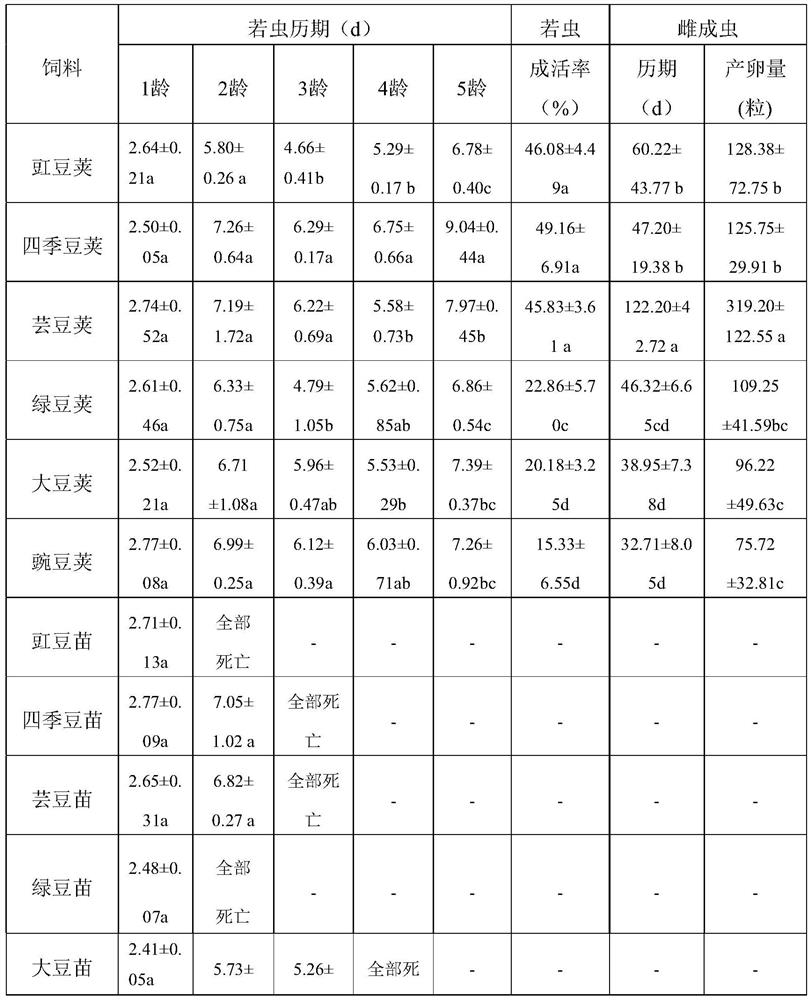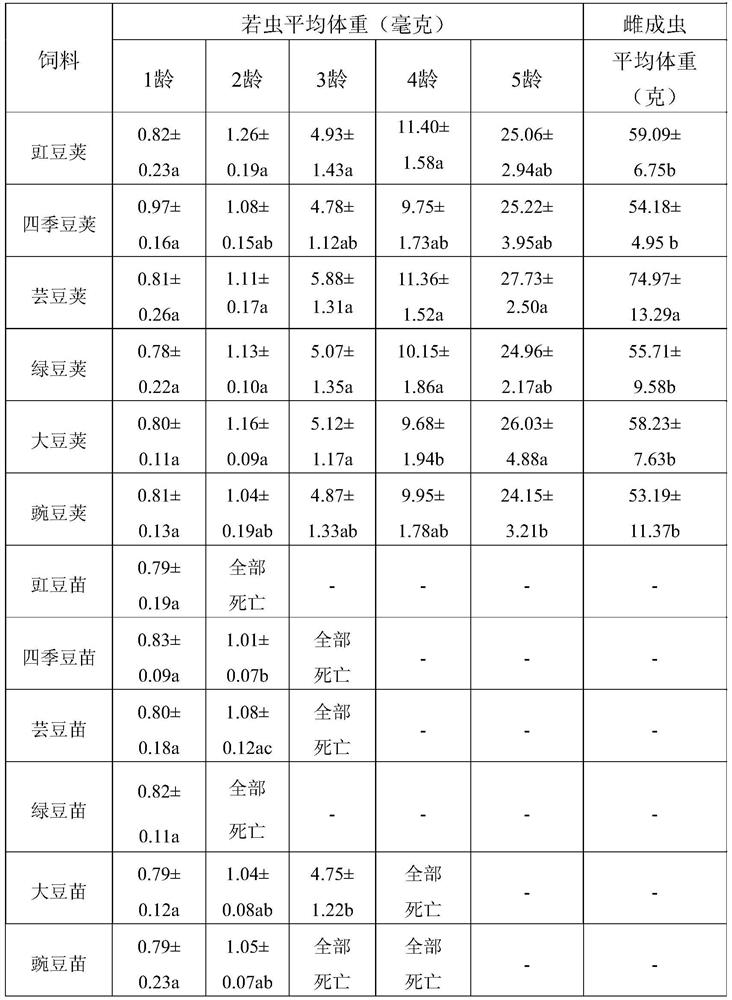Method for artificially feeding riptortus pedestris in whole growth period
A technology of full growth period and stinkbug, which is applied in animal feed, animal feed, application, etc., to achieve the effect of prolonging the spawning period, increasing the hatching rate, and promoting normal growth and development
- Summary
- Abstract
- Description
- Claims
- Application Information
AI Technical Summary
Problems solved by technology
Method used
Image
Examples
Embodiment 1
[0068] Example 1: Screening of suitable feed for adult and nymph artificial rearing of stink bugs
[0069] In a constant temperature room with a temperature of 25° C., a relative humidity of 40%, and a photoperiod of (fluorescent tubes, close to natural light) L:D=16:8, different feeds were used to feed the nymphs and adults of the stink bug. Green and tender pods of cowpea, kidney bean, kidney bean, soybean, mung bean, pea, etc. are purchased from the market, and are sterilized and kept fresh in the laboratory. The bean sprouts are sown in the greenhouse, and seedlings aged 7 to 10 days after emergence are used. The average body weight of nymphs and adults of different ages of the stinkbug at the measuring point was taken within 24 hours after moulting. The results are shown in Table 1 and Table 2.
[0070] Table 1 Example 1 The developmental duration and adult oviposition of the adults and nymphs of the stinkbug stinkbug in different feeding sites
[0071]
[0072]
[...
Embodiment 2
[0076] Example 2: Screening of the suitable temperature for artificial rearing of stinkbug adults and nymphs
[0077] The relative humidity in the thermostatic chamber is set to be 40%, and the photoperiod is (fluorescent tube, close to natural light) L: D=16:8, with kidney bean pods (purchased on the market, disinfected and fresh-keeping treated in the laboratory) as feed. The temperature is respectively 15 ℃, 20 ℃, 25 ℃, 30 ℃, 35 ℃ in the thermostatic chamber to rear the nymphs and adults of the stink bug. The results are shown in Table 3 and Table 4.
[0078] Table 3 Example 2 The developmental duration and adult oviposition of the adults and nymphs of the stink bug at different temperature feeding points
[0079]
[0080] Table 4 Example 2 The average body weight of the adults and nymphs of stink bugs at different temperature feeding points
[0081]
[0082]
[0083] Conclusion: With the increase of temperature, the duration of nymphs and adults of stinkbug is s...
Embodiment 3
[0084] Example 3: Screening of optimum temperature for hatching of stinkbug eggs
[0085] The relative humidity in the constant temperature room is set to be 40%, the light cycle is (fluorescent tube, close to natural light) L: D=16:8, and the kidney bean pods (purchased on the market, disinfected and kept fresh in the laboratory) are used as feed, and the collection point The eggs laid within 24 hours by the adult stinkbugs are hatched in thermostatic chambers with temperatures set at 15°C, 20°C, 25°C, 30°C, and 35°C. The results are shown in Table 5.
[0086] Table 5 Example 3 The hatching duration and egg hatching rate of stink bug eggs under different temperatures
[0087] temperature Egg incubation period (d) Egg hatching rate (%) 15℃ 35.83±0.95a 70.27±11.45c 20℃ 15.07±0.68b 88.41±10.36b 25℃ 10.23±0.36c 98.12±1.74a 30℃ 6.69±0.25d 98.70±1.12a 35℃ 5.23±0.44e 95.08±3.29ab
[0088] Conclusion: The duration of eggs shortens wit...
PUM
 Login to View More
Login to View More Abstract
Description
Claims
Application Information
 Login to View More
Login to View More - R&D
- Intellectual Property
- Life Sciences
- Materials
- Tech Scout
- Unparalleled Data Quality
- Higher Quality Content
- 60% Fewer Hallucinations
Browse by: Latest US Patents, China's latest patents, Technical Efficacy Thesaurus, Application Domain, Technology Topic, Popular Technical Reports.
© 2025 PatSnap. All rights reserved.Legal|Privacy policy|Modern Slavery Act Transparency Statement|Sitemap|About US| Contact US: help@patsnap.com



